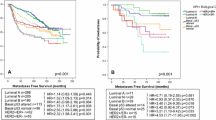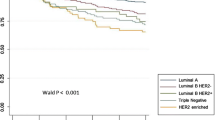Abstract
Background. To investigate the correlation among some of the commonly used clinical, pathological factors and newer biological indicators, and to identify the independent predictors of distant metastasis at presentation in patients with breast cancer.
Methods. The pathological specimens from 73 patients with breast cancer were retrospectively evaluated by immunohistochemistry. Data on 13 biological indicators; ER, PR, P53, c-erbB-2, PCNA, CEA, Ki-67, Vimentin, Ulex, Nm23, Cathepsin D, Factor VIII, PS2 together with clinical and pathological factors were collected.
Results. A number of highly significant correlations were found among the biological indicators studied. By logistic regression analysis, the predictors of distant metastasis at presentation in univariate tests were tumor diameter, number of lymph nodes involved, P53, c-erbB-2 and grade. In multivariate analysis, tumor diameter (P=0.042, HR: 1.88(1.02–3.44)), c-erbB-2 expression (P=0.035, HR: 18.20 (1.23–268.66)) and grade (P=0.010, HR: 8.05(1.66–39.00)) retained their significance.
Conclusion. Our findings show that inactivation of suppressor genes, expression of oncogenes, loss of differentiation, augmentation of proliferative activity, metastatic potential, angiogenesis and hormone receptor status are all interrelated facets of breast cancer pathogenesis. Patients with tumors overexpressing c-erbB-2 or with bigger or higher-grade tumors probably need to be more carefully evaluated for the presence of distant metastasis, thus be better staged, at presentation. This may be a new reason to test c-erbB-2 routinely in all patients with breast cancer in addition to its well-known prognostic and predictive uses.
Similar content being viewed by others

References
Gusterson B, Machin L, Gullick W, Gibbs NM, Powles TJ, Price P, McKinna A, Harrison S: Immunohistochemical distribution of c-erbB2 in infiltrating and in situ breast cancer. Int J Cancer 842-845, 1988
Berns EM, Foekens JA, Van Stavaren IL, Van Putten WL, de Koning HY, Portengen H, Klijn JG: Oncogene amplification and prognosis in breast cancer: relationship with systemic treatment. Gene 159: 11-18, 1995
Hayes DF, Yamauchi H, Stearns V, Brotzman M, Isaacs C, Trock B: Should all breast cancers be tested for c-erb-B2? In: Perry MC (ed) ASCO 2000 Educational Book. Baltimore, American Society of Clinical Oncology, 2000, pp 257-265
Savas B, Karaveli S, Uslu G, Basaran L: Significance of P53 and c-erbB-2 for predicting response to CMF treatment in breast carcinoma. Proc ASCO 18: 378 (abstr), 1999
Culotta E, Koshland D: Molecules of the year: P53 sweeps through cancer research. Science 262: 1958-1961, 1993
Sauer T, Furu I, Beraki K, Jebsen PW, Ormerod E, Naess O. Nm 23 protein expression in fine-needle aspirates from breast carcinoma. Cancer Cytopathol 84: 109-114, 1998
Flores-Rozas H, Kelman Z, Dean FB, Pan ZQ, Harper JW, Elledge SJ, O'Donnell M, Hurwitz J. Cdk-interacting prote in 1 directly binds with proliferating cell nuclear antigen and inhibits DNA replication catalyzed by the DNA polymerase ? holoenzyme. Proc Natl Acad Sci USA 91: 8655-8659, 1994
Rochefort H, Augereau P, Capony F, Garcia M, Cavailles V, Freiss G, Morisset M, Vignon F. The 52k cathepsin-D of breast cancer; structure, regulation, function and clinical value. Cancer Treat Res 40: 207-212, 1988
Foekens JA, Rio MC, Seguin P, Van Putten WL, Fauque J, Nap M: Prediction of relapse and survival in breast cancer patients by PS2 protein status. Cancer Res 50(13): 3832-3837, 1990
Gillesby BE, Zacharewski TR: PS2 (TFF1) levels in human breast cancer tumor samples: correlation with clinical and histological prognostic markers. Breast Cancer Res Treat 56(3): 253-265, 1999
Kato T, Kimura T, Ishii N, Fujii A, Yamamoto K, Kameoka S, Nishikawa T, Kasajima T: The methodology of quantification of microvessel density and prognostic value of neovascularisation associated with long-term survival in Japanese patients with breast cancer. Breast Cancer Res Treat 53(1): 19-31, 1999
Badenoch-Jones P, Claudianos C, Ramshaw IA. Lectinbinding characteristics of related high and low metastatic rat mammary adenocarcinoma cell lines. Invasion Metastasis 7(5): 284-296, 1987
Nielsen NH, Loden M, Cajander J, Emdin SO, Landberg G. G1-S transition defects occur in most breast cancers and predict outcome. Breast Cancer Res Treat 56(2): 105-121, 1999
Crosier M, Scott D, Wilson RG, Griffiths CD, May FE, Westley BR: Differences in Ki67 and c-erbB2 expression between screen detected and true interval breast cancers. Clin Cancer Res 5(10): 2682-2688, 1999
Thomas PA, Kirschmann DA, Cerhan JR, Folberg R, Seftor EA, Sellers TA, Hendrix MJ: Association between keratin and vimentin expression, malignant phenotype and survival in postmenopausal breast cancer patients. Clin Cancer Res 5(10): 2698-2703, 1999
Paridaens R, Sylvester RJ, Ferrazzi E, Legros N, Leclercq G, Heuson JC: Clinical significance of the quantitative assessment of estrogen receptors in advanced breast cancer. Cancer 46: 2889-2895, 1980
Coppola D, Catalano E, Nicosio SV. Significance of P53 and bcl-2 protein expression in human breast ductal carcinoma. Cancer Control, JMCC 6(2): 181-187, 1999
Barbareschi M, Leonardi E, Mauri FA, Serio G, Dalla Palma: P53 and c-erbB-2 protein expression in breast carcinomas. An immunohistochemical study including correlations with receptor status, proliferation markers, and clinical stage in human breast cancer. Am J Clin Pathol 98(4): 408-418, 1992
Rudolph P, MacGrogan G, Bonichon F, Frahm SO, de Mascarel I, Trojani M, Durand M, Avril A, Coindre JM, Parwaresch R: Prognostic significance of Ki-67 and topoisomerase II alpha expression in infiltrating ductal carcinoma of the breast. A multivariate analysis of 863 cases. Breast Cancer Res Treat 55(1): 61-71, 1999
Kawabata K, Watanabe K, Ozaki S. Expression of PS2 protein in breast cancer. Rinsho Byori 44(7): 647-652, 1996
Reshkin SJ, Tedone T, Correale M, Mangia A, Casavola V, Paradiso A. Association of PS2 (TFF1) with breast tumor proliferative rate: in vitro and in vivo studies. Cell Prolif 32(2-3) 107-118, 1999
Soubeyran I, Wafflart J, Bonichon F, de Mascarel I, Trojani M, Durand M, Avril A, Coindre JM. Immunohistochemical determination of PS2 in invasive breast carcinomas: a study on 942 cases. Breast Cancer Res Treat 34(2): 119-128, 1995
Besse G, Kwiatkowski F, Gaillard G, Daver A, Dalifard I, Basuyau JP, Brunelle P, Wafflart J, Angibeau RM, Auvray E. PS2 as a prognostic factor in 1065 cases of human breast cancer. A multicenter study. Bull Cancer 81(4): 289-296, 1994
Nieto Y, Cagnoni PJ, Nawaz S, Shpall EJ, Yerushalmi R, Cook B, Russell P, McDermit J, Murphy J, Bearman SI, Jones RB. Evaluation of predictive value of Her-2/neu overexpression and P53 mutations in high-risk primary breast cancer patients treated with high-dose chemotherapy and autologous stem-cell transplantation. J Clin Oncol 18(10): 2070-2080, 2000
Author information
Authors and Affiliations
Rights and permissions
About this article
Cite this article
Bozcuk, H., Uslu, G., Peştereli, E. et al. Predictors of distant metastasis at presentation in breast cancer: a study also evaluating associations among common biological indicators. Breast Cancer Res Treat 68, 239–248 (2001). https://doi.org/10.1023/A:1012269804578
Issue Date:
DOI: https://doi.org/10.1023/A:1012269804578



